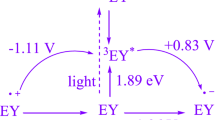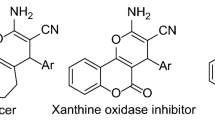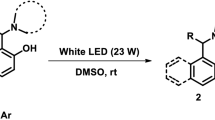Abstract
By employing the Knoevenagel–Michael tandem cyclocondensation of malononitrile, aldehydes, and resorcinol, we developed a green method for the radical synthesis of 2-amino-4 H-chromene scaffolds. A photo-induced electron transfer (PET) photocatalyst was employed in an aqueous solution to use visible light as a renewable energy source. This study aims to develop a non-metal dye that is inexpensive and easily accessible. In addition to having speed-saving features and being simple to use, the photochemically catalyzed AYG demonstrates high yields, energy efficiency, and environmental friendliness. This makes it possible to track changes in chemical and environmental variables throughout time. It is amazing that gram-scale cyclization is practical, proving that it has industrial applications.




Similar content being viewed by others
References
Patel RI, Sharma A, Sharma S, Sharma A (2021) Visible light-mediated applications of methylene blue in organic synthesis. Org Chem Front 8:1694–1718. https://doi.org/10.1039/D0QO01182G
Politano F, Oksdath-Mansilla G (2018) Light on the horizon: current research and future perspectives in flow photochemistry. Org Process Res Dev 22:1045–1062. https://doi.org/10.1021/acs.oprd.8b00213
R.H. Verschueren, W.M. de Borggraeve, Electrochemistry and photoredox catalysis: a comparative evaluation in organic synthesis, Molecules 24 (2019): 2122–2160, https://doi.org/10.3390/molecules24112122.
Tangelder GJ, Janssens CJ, Slaaf DW, Oude Egbrink MG, Reneman RS (1995) In vivo differentiation of leukocytes rolling in mesenteric postcapillary venules. Am J Phys 268:909–915. https://doi.org/10.1152/ajpheart.1995.268.2.H909
Teuber M, Rögner M, Berry S (2001) Fluorescent probes for non-invasive bioenergetics studies of whole cyanobacterial cells. Biochimica et Biophysica Acta 1506:31–46. https://doi.org/10.1016/S0005-2728(01)00178-5
Vincent WS, Goldstein ES (1981) Rapid preparation of covalently closed circular DNA by acridine yellow affinity chromatography. Anal Biochem 110:123–127. https://doi.org/10.1016/0003-2697(81)90121-4
Goryacheva IYu, Melnikov GV, Shtykov SN (2000) Acridine dyes in the triplet state as reagents for the selective luminescence determination of polycyclic aromatic hydrocarbons. J Anal Chem 55:874–878. https://doi.org/10.1007/BF02757853
Pérez-Ruíz T, Martínez-Lozano C, Tomás V, Fenoll J (2003) Spectrofluorimetric determination of formaldehyde by a flow-injection method based on its catalytic effect on the acridine yellow-bromate reaction. Anal Bioanal Chem 375:661–665. https://doi.org/10.1007/s00216-003-1763-y
Pérez-Ruiz T, Martínez-Lozano C, Sanz A, San Miguel T (1997) Flow extraction spectrophotometric method for the determination of diclofenac sodium in pharmaceutical preparations. J Pharm Biomed Anal 16:249–254. https://doi.org/10.1016/S0731-7085(97)00028-9
Arques A, Amat AM, Santos-Juanes L, Vercher RF, Marin ML, Miranda MA (2009) Abatement of methidathion and carbaryl from aqueous solutions using organic photocatalysts. Catal Today 144:106–111. https://doi.org/10.1016/j.cattod.2008.11.013
Amat AM, Arques A, Galindo F, Miranda MA, Santos-Juanes L, Vercher RF, Vicente R (2007) Acridine yellow as solar photocatalyst for enhancing biodegradability and eliminating ferulic acid as model pollutant. Appl Catal B: Environ 73:220–226. https://doi.org/10.1016/j.apcatb.2006.12.003
Takemura F (1962) Dye-sensitized photopolymerization of vinyl monomers. II. Photobleaching of acridine yellow in some vinyl monomers. Bull Chem Soc Jpn 35:1078–1086. https://doi.org/10.1246/bcsj.35.1078
Saint-Cricq P, Pigot T, Blanc S, Lacombe S (2012) Selective oxidation with nanoporous silica supported sensitizers: an environment friendly process using air and visible light. J Hazard Mater 211–212:266–274. https://doi.org/10.1016/j.jhazmat.2011.09.066
Webb RB, Hass BS, Kubitschek HE (1979) Photodynamic effects of dyes on bacteria. II. Genetic effects of broad-spectrum visible light in the presence of acridine dyes and methylene blue in chemostat cultures of Escherichia coli. Mutat Res 59:l–13. https://doi.org/10.1016/0027-5107(79)90190-8
Kostjukova LO, Leontieva SV, Kostjukov VV (2021) The vibronic absorption spectra and electronic states of acridine yellow in aqueous solution. J Mol Liq 326:115312. https://doi.org/10.1016/j.molliq.2021.115312
Mohamadpour F (2020) Visible light irradiation promoted catalyst-free and solvent-free synthesis of pyrano[2,3-d]pyrimidine scaffolds at room temperature. J Saudi Chem Soc 24:636–641. https://doi.org/10.1016/j.jscs.2020.06.006
Mohamadpour F (2021) Catalyst-free, visible light irradiation promoted synthesis of spiroacenaphthylenes and 1H-pyrazolo[1,2-b]phthalazine-5,10-diones in aqueous ethyl lactate. J Photochem Photobiol A: Chem 407:113041. https://doi.org/10.1016/j.jphotochem.2020.113041
Mohamadpour F (2021) Catalyst-Free and Solvent-Free visible light assisted synthesis of Tetrahydrobenzo[b]Pyran Scaffolds at Room temperature. Polycycl Aromat Compd. https://doi.org/10.1080/10406638.2021.2006244
Kathrotiya HG, Patel MP (2012) Microwave-assisted synthesis of 30-indolyl substituted 4H-chromenes catalyzed by DMAP and their antimicrobial activity. Med Chem Res 21:3406–3416. https://doi.org/10.1007/s00044-011-9861-4
Alvey L, Prado S, Saint-Joanis B, Michel S, Koch M, Cole ST, Tillequin F, Janin YL (2009) Diversity-oriented synthesis of furo[3,2-f]chromanes with antimycobacterial activity. Eur J Med Chem 44:2497–2505. https://doi.org/10.1016/j.ejmech.2009.01.017
Moon DO, Kim KC, Jin CY, Han MH, Park C, Lee KJ, Park YM, Choi YH, Kim GY (2007) Inhibitory effects of eicosapentaenoic acid on lipopolysaccharide-induced activation in BV2 microglia. Int Immunopharmacol 7:222–229. https://doi.org/10.1016/j.intimp.2006.10.001
Kumar D, Reddy VB, Sharad S, Dube U, Kapur S (2009) A facile one-pot green synthesis and antibacterial activity of 2-amino- 4H-pyrans and 2-amino-5-oxo-5,6,7,8-tetrahydro-4Hchromenes. Eur J Med Chem 44:3805–3809. https://doi.org/10.1016/j.ejmech.2009.04.017
Symeonidis T, Chamilos M, Hadjipavlou-Litina DJ, Kallitsakis M, Litinas KE (2009) Synthesis of hydroxycoumarins and hydroxybenzo[f]- or [h]coumarins as lipid peroxidation inhibitors. Bioorg Med Chem Lett 19:1139–1142. https://doi.org/10.1016/j.bmcl.2008.12.098
Narender T, Gupta S (2009) A convenient and biogenetic type synthesis of few naturally occurring chromeno dihydrochalcones and their in vitro antileishmanial activity. Bioorg Med Chem Lett 19:3913–3916. https://doi.org/10.1016/j.bmcl.2004.05.071
Rueping M, Sugiono E, Merino E (2008) Asymmetric organocatalysis: an efficient enantioselective access to benzopyranes and chromenes. Chem—A Eur J 14:6329–6332. https://doi.org/10.1002/chem.200800836
Flavin MT, Rizzo JD, Khilevich A, Kucherenko A, Sheinkman AK, Vilaychack V, Lin L, Chen W, Greenwood EM, Pengsuparp T, Pezzuto JM, Hughes SH, Flavin TM, Cibulski M, Boulanger WA, Shone RL, Xu ZQ (1996) Synthesis, Chromatographic Resolution, and anti-human immunodeficiency virus activity of (±)-Calanolide A and its enantiomers. J Med Chem 39:1303–1313. https://doi.org/10.1021/jm950797i
F.M. Abdelrazeka, P. Metza, E.K. Farrag, Synthesis and molluscicidal activity of 5-oxo-5,6,7,8-tetrahydro-4H-chromene derivatives, Archiv der Pharmazie 337 (2004): 482–485, https://doi.org/10.1002/ardp.200400881.
Paliwal PK, Jetti SR, Jain S (2013) Green approach towards the facile synthesis of dihydropyrano(c)chromene and pyrano[2,3-d]-pyrimidine derivatives and their biological evaluation. Med Chem Res 22:2984–2990. https://doi.org/10.1007/s00044-012-0288-3
Cai SX, Drewe J, Kemnitzer W (2009) Discovery of 4-aryl-4Hchromenes as potent apoptosis inducers using a cell- and caspase-based anti-cancer screening apoptosis program (ASAP): SAR studies and the identification of novel vascular disrupting agents. Anti-Cancer Agents Med Chem 9:437–456
Wang JL, Liu DX, Zhang ZJ, Shan SM, Han XB, Srinivasula SM, Croce CM, Alnemri ES, Huang ZW (2000) Structure based discovery of an organic compound that binds Bcl-2 protein and induces apoptosis of tumor cells. Proc Natl Acad Sci 97:7124–7129
Huynh THV, Abrahamsen B, Madsen KK, Gonzalez- Franquesa A, Jensen AA, Bunch L (2012) Design, synthesis and pharmacological characterization of coumarin-based fluorescent analogs of excitatory amino acid transporter subtype 1 selective inhibitors, UCPH-101 and UCPH-102. Bioorg Med Chem 20:6831–6839. https://doi.org/10.1016/j.bmc.2012.09.049
Mohamadpour F (2021) Per-6-NH2-β-CD as supramolecular host and reusable aminocyclodextrin promoted solvent-free synthesis of 2-Amino-4H-Chromene scaffolds at Room temperature. Polycycl Aromat Compd. https://doi.org/10.1080/10406638.2021.1983615
Mohamadpour F (2022) New Role for Photoexcited Na2 eosin Y via the direct hydrogen atom transfer process in Photochemical visible-Light-Induced synthesis of 2-Amino-4H-Chromene scaffolds under Air Atmosphere. Front Chem 10:880257. https://doi.org/10.3389/fchem.2022.880257
Datta B, Pasha MA (2012) Glycine catalyzed convenient synthesis of 2-amino-4H-chromenes in aqueous medium under sonic condition. Ultrason Sonochem 19:725–728. https://doi.org/10.1016/j.ultsonch.2012.01.006
Pawar GT, Magar RR, Lande MK (2018) Mesolite: an efficient Heterogeneous Catalyst for One-Pot synthesis of 2-Amino-4H-chromenes. Polycycl Aromat Compd 38:75–84. https://doi.org/10.1080/10406638.2016.1159584
Dekamin MG, Eslami M (2014) Highly efficient organocatalytic synthesis of diverse and densely functionalized 2-amino-3-cyano-4H-pyrans under mechanochemical ball milling. Green Chem 16:4914–4921. https://doi.org/10.1039/C4GC00411F
Eshtehardian B, Rouhani M, Mirjafary Z (2020) Green protocol for synthesis of MgFe2O4 nanoparticles and study of their activity as an efficient catalyst for the synthesis of chromene and pyran derivatives under ultrasound irradiation. J Iran Chem Soc 17:469–481. https://doi.org/10.1007/s13738-019-01783-3
Hosseinzadeh-Baghan S, Mirzaei M, Eshtiagh-Hosseini H, Zadsirjan V, Heravi MM, Mague JT (2020) An inorganic–organic hybrid material based on a keggin type polyoxometalate@Dysprosium as an effective and green catalyst in the synthesis of 2-amino-4H-chromenes via multicomponent reactions. Appl Organomet Chem 34:e5793-5816. https://doi.org/10.1002/aoc.5793
Albadi J, Mansournezhad A (2016) Aqua-mediated multicomponent synthesis of various 4H-pyran derivatives catalyzed by poly (4-vinylpyridine)-supported copper iodide nanoparticle Catalyst. Res Chem Intermed 42:5739–5752. https://doi.org/10.1007/s11164-015-2400-z
Baghbanian SM, Rezaei N, Tashakkorian H (2013) Nanozeolite clinoptilolite as a highly efficient heterogeneous catalyst for the synthesis of various 2-amino-4H-chromene derivatives in aqueous media. Green Chem 15:3446–3458. https://doi.org/10.1039/C3GC41302K
Kantharaju K, Khatavi SY (2018) Microwave accelerated synthesis of 2-Amino-4H-Chromenes catalyzed by WELFSA: a Green Protocol. ChemistrySelect 3:5016–5024. https://doi.org/10.1002/slct.201800096
Kundu SK, Mondal J, Bhaumik A (2013) Tungstic acid functionalized mesoporous SBA-15: a novel heterogeneous catalyst for facile one-pot synthesis of 2-amino-4H-chromenes in aqueous medium. Dalton Trans 42:10515–10524. https://doi.org/10.1039/C3DT50947H
Saikia M, Saikia L (2016) Sulfonic acid-functionalized MIL-101(cr) as a highly efficient heterogeneous catalyst for one-pot synthesis of 2-amino-4H-chromenes in aqueous medium. RSC Adv 6:15846–15853. https://doi.org/10.1039/C5RA28135K
Shaikh MA, Farooqui M, Abed S (2019) Novel task–specific ionic liquid [Et2NH(CH2)2CO2H][AcO] as a robust catalyst for the efficient synthesis of some pyran–annulated scaffolds under solvent–free conditions. Res Chem Intermed 45:1595–1617. https://doi.org/10.1007/s11164-018-3696-2
Zolfigol MA, Yarie M, Baghery S (2016) Application of {[4,4′-BPyH][C(CN)3]2} as a bifunctional nanostructured molten Salt catalyst for the preparation of 2-Amino-4Hchromene derivatives under solvent-free and benign conditions. Synlett 27:1418–1422. https://doi.org/10.1055/s-0035-1561345
Sing Raghuvanshi D, Nand Singh K (2010) An expeditious synthesis of Novel pyranopyridine derivatives involving chromenes under controlled microwave irradiation. Arkivok. https://doi.org/10.3998/ark.5550190.0011.a25
Kale SR, Kahandal SS, Burange AS, Gawande MB, Jayaram RV (2013) A benign synthesis of 2-amino-4H-chromene in aqueous medium using hydrotalcite (HT) as a heterogeneous base catalyst. Catal Sci Technol 3:2050–2056. https://doi.org/10.1039/C3CY20856G
Safari J, Zarnegar Z, Heydarian M (2012) Magnetic Fe3O4 nanoparticles as efficient and reusable catalyst for the green synthesis of 2-amino-4H-chromene in aqueous media. Bull Chem Soc Jpn 85:1332–1338. https://doi.org/10.1246/bcsj.20120209
Sadeghi B, Arabian E, Akbarzadeh E (2020) Nano-cellulose-OTiCl3 as a green and efficient catalyst for one-pot synthesis of 2-amino-7-hydroxy-4-aryl-4 H-chromene-3-carbonitrile. Inorg Nano-Metal Chem 50:1207–1212. https://doi.org/10.1080/24701556.2020.1739076
Mohamadpour F (2022) The development of Friedländer heteroannulation through a single electron transfer and energy transfer pathway using methylene blue (MB+). Sci Rep 12:7253. https://doi.org/10.1038/s41598-022-11349-8
Mohamadpour F (2021) New role for photoexcited organic dye, Na2 eosin Y via the direct hydrogen atom transfer (HAT) process in photochemical visible-light-induced synthesis of spiroacenaphthylenes and 1H-pyrazolo[1,2-b]phthalazine-5,10-diones under air atmosphere. Dyes Pigments 194:109628. https://doi.org/10.1016/j.dyepig.2021.109628
Mohamadpour F (2022) The development of imin-based tandem Michael–Mannich cyclocondensation through a single-electron transfer (SET)/energy transfer (EnT) pathway in the use of methylene blue (MB+) as a photo-redox catalyst. RSC Adv 12:10701–10710. https://doi.org/10.1039/D2RA01190E
Mohamadpour F (2022) Visible-light-induced radical condensation cyclization to synthesize 3, 4-Dihydropyrimidin-2-(1H)-ones/thiones using Photoexcited Na2 eosin Y as a direct hydrogen atom transfer (HAT) Catalyst. ACS Omega 7:8429–8436. https://doi.org/10.1021/acsomega.1c05808
Acknowledgements
We gratefully acknowledge financial support from the Research Council of the Apadana Institute of Higher Education.
Author information
Authors and Affiliations
Contributions
FM wrote the main manuscript text and FM prepared Figs. 1, 2, 3 and 4. FM reviewed the manuscript.
Corresponding author
Ethics declarations
Conflict of interest
The authors declare no competing interests.
Additional information
Publisher’s Note
Springer Nature remains neutral with regard to jurisdictional claims in published maps and institutional affiliations.
Supplementary Information
Below is the link to the electronic supplementary material.
Rights and permissions
Springer Nature or its licensor (e.g. a society or other partner) holds exclusive rights to this article under a publishing agreement with the author(s) or other rightsholder(s); author self-archiving of the accepted manuscript version of this article is solely governed by the terms of such publishing agreement and applicable law.
About this article
Cite this article
Mohamadpour, F. Acridine Yellow G-catalyzed Visible-Light-Promoted Synthesis of 2-amino-4 H-chromene Scaffolds via a Photo-Induced Electron Transfer Process in an Aqueous Media. Catal Surv Asia 27, 306–317 (2023). https://doi.org/10.1007/s10563-023-09397-9
Received:
Accepted:
Published:
Issue Date:
DOI: https://doi.org/10.1007/s10563-023-09397-9




